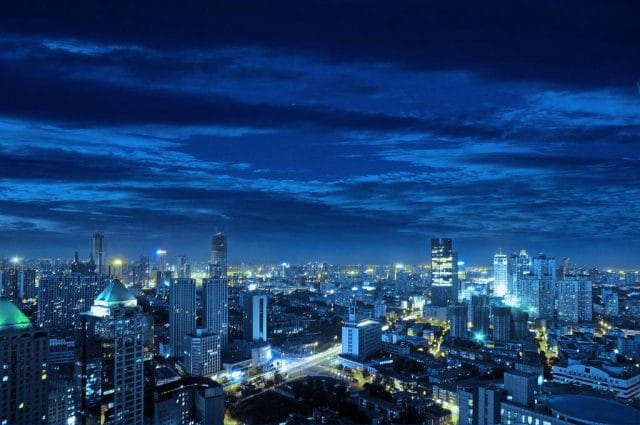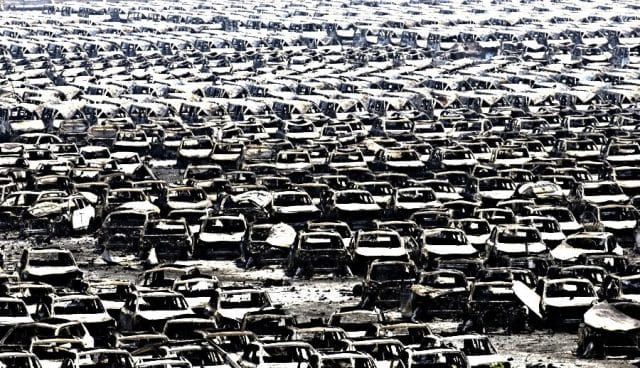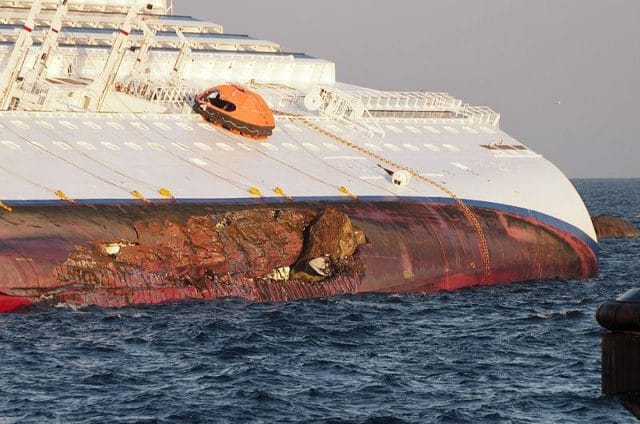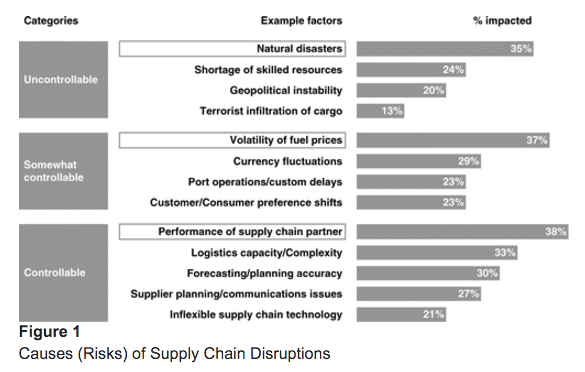
This post is adapted from the blog of Flexport, a Priceonomics customer. Photo by 墨色鲜艳.
Does your company have interesting data or insights? Become a Priceonomics customer.
![]()
You may not know the name Tianjin, but when an explosion in its port destroyed warehouses, cars, and other cargo with the force of 21 tons of detonating TNT, it affected most major companies that sell products you know.
If you had to choose one city to represent globalization, Tianjin would be a decent choice. The Chinese city of 11+ million is home to one the world’s one of the world’s largest ports, offices for nearly three hundred Fortune 500 companies, and factories that build cars, airplane parts, and mobile phones.
But the impressive economic engine of Tianjin came to a halt on August 12, 2015, when a warehouse full of hazardous chemicals exploded. “First I saw some splashes of fire,” a university student told the press, “and then a big fire ball after a few seconds.” A worker added, “It sounded like the start of a war. I thought maybe Japan was bombing our port.” The explosion killed over 100 people, and the Chinese government closed or restricted access to most of the port.
In the world of shipping and trade, this was a really big deal. Initial estimates made by insurers of the amount they’d pay for damaged cargo were around $1.5 to $2 billion. Then insurers increased the estimate to above $3 billion. Then to as much as $6 billion, which would make Tianjin the largest disaster in maritime history in terms of monetary damages.

Destroyed cars in the Tianjin port. Photo by Quapan
The Tianjin disaster was an equally big deal for companies that rely on products and supplies coming from the city. The explosion destroyed more than 10,000 Toyota, Hyundai, and Range Rover cars and prevented the shipment of others from nearby factories. Additional impacted companies ranged from John Deere to the drug company GlaxoSmithKline.
But for all the tragedy and concern, the impact on global trade of what may turn out to be the largest (commercial) disaster in maritime history has so far been limited. Here’s why.
The Giant Hairball of World Trade
To understand how impactful the Tianjin disaster could be, it helps to appreciate the relative ease of world trade.
For decades, shipping companies have built larger and larger ships to drive down the cost of transporting cargo. Terry Cummings, the Vice President of Roanoke Trade, points out that rates for cargo insurance are as low as they’ve ever been. That’s largely because significant damages are rare—affecting only 1% or so of cargo according to the International Union of Marine Insurance.
This is the reality that leads companies to source, build, and deliver products all over the world. It also helps explain the dynamic documented by academics Sameer Kumar and Gail Harrison: that “in one industry after another, supply chains have been stretched further than they have ever been in the past and lean, just-in-time production schedules have made the consequences of a disruption more severe.”
It is this faith in the stability of trade networks that makes disasters like Tianjin so damaging. When an earthquake in Taiwan delayed the delivery of semiconductors that Apple used in its laptops in 1999, it shipped customers slower computers that used older components. In response to complaints, the company eventually offered refunds, and many customers cancelled their orders. Similarly, shoe factories in Kobe, Japan, experienced a 90% hit in business after an earthquake hit the city, prevented them from shipping product, and alienated their clients. Large companies that experience disruptions from events like these can see their stock price decrease more than 30%.
So beyond the initial destruction or delayed delivery of products that were in the port on August 12, it’s these indirect consequences of Tianjin that businesses are still trying to understand.
“Supply chains are not brackets like in March Madness,” Wayne Caccamo, the Chief Marketing Officer of Resilinc, tells us. “Supply chains are hairballs.” Most companies have many suppliers that get parts from multiple, smaller suppliers who each rely on different (or possibly the same) suppliers. For companies with these deep, intertwined supply chains, there’s a lot of potential to be surprised by the effects of Tianjin.
This is why Tianjin could have an outsize impact on how trade and business operates in the future: worries about uncertain ripple effects from disasters like Tianjin challenge the notion of a safe and stable trade system that businesses rely on.
It’s also made many in the shipping industry suspect that their industry is riskier than they realized. The great fear is normally of a giant cargo ship sinking or running aground. But an explosion in a busy port can destroy the cargo of dozens of ships.
After the explosion in Tianjin, Ed Noonan, the chief executive of a major insurance company, berated his industry for being “surprised” at the extent of damages that result from port disasters.
Keep Calm and Export On
The Tianjin explosion was so large that it could be seen from space, and for people who live and work at the port, it will take years for normalcy to return. But in terms of economic impact, despite the intense concern among industry insiders, there are also signs that Tianjin’s effects are unremarkable.
The most recent estimates of the damages insurers will need to pay is $6 billion. Resilinc, which helps companies understand potential risks in their supply chain, has estimated the potential cost to businesses from the disruptions caused by Tianjin. That estimate, based on working with suppliers around Tianjin, is $9 billion in “value-at-risk” or “revenue impact.”
These are big numbers for the cargo insurance industry: the biggest expense in history, if the estimates are accurate. But as far as major disasters go, Tianjin is tragic but not chart-busting. Resilinc’s estimate of the disruption to supply chains ($9 billion) only rank Tianjin as the 3rd most damaging disaster of 2015—two typhoons that hit Taiwan, Japan, and the Philippines rank 1st and 2nd after causing $10-20 billion in value-at-risk.

Cargo and marine insurers usually worry about disasters befalling large ships: like when the Costa Concordia cruise ship hit an underground rock and sank in 2012. Photo credit: Rvongher
The trade publication Artemis also notes that despite Tianjin, economic losses from disasters were below average in 2015: only $85 billion compared to $113 billion in 2014 and a 10-year average of $192 billion. Rates for cargo insurance and reinsurance have continued to decline since Tianjin.
There are a few reasons why the Tianjin had a relatively light price tag despite the devastation it caused.
One is that the explosions happened at night, which reduced the humanitarian toll. Another is that it destroyed large, bulky cargo that couldn’t be as concentrated in the site of the blast. “We were very fortunate that the cargo was [mostly] automobiles,” an insurance company executive explained in the 3rd quarter earnings call of the insurer Validus Holdings. “Had the affected area been comprised of containers full of electronic components, the loss would be many times larger.”
While the explosion kindled fears of a bottleneck for trade, companies have also had more options to avoid disruptions than they do when facing other disasters. “Tianjin was more of a logistics issue,” says Wayne Caccamo of Resilinc. “In other events, we had hurricanes take down whole manufacturing sites. But in the case of moving goods, you can move inventory around, there’s safety stock. There are options used by companies that can mute the effect.” China is home to 7 of the world’s 10 busiest ports, so companies could avoid the Tianjin bottleneck.
Tianjin also had more of an effect on cargo (rather than on broader supply chains) because the explosion destroyed storage and logistics areas—not the port terminals where ships load and unload. Even if not at full efficiency, ships have been loading and unloading since the day after the accident. And since Tianjin is in northern China, one of the best-served areas in the world when it comes to logistics, companies could also adapt by utilizing the nearby ports of Dalian and Qingdao.
So while insurers will worry about future port explosions that damage huge amounts of cargo, for companies worried about shipping products and parts, Tianjin seems more in line with the surprising conclusion of people who study supply chain management: that disasters matter less than more small, everyday disruptions.
Research by Accenture, for example, has found that mundane factors—like delays due to poorly performing suppliers—are responsible for more supply chain disruptions and revenue hits than natural disasters. Analysts at Resilinc have come to the same conclusion from looking at their data, which shows that factory fires are the most disruptive events, followed by mergers and acquisitions.
Causes of Supply Chain Disruptions

Data from Patrick Byrne and Accenture; graphic by Sameer Kumar and Gail Harrison in “Expect the Unexpected”
“There are categories you just wouldn’t think of,” Wayne Caccamo explains. “With Mergers & Acquisitions, information gets lost and there are disruptions for simple reasons like addresses getting mixed up.”
Tianjin is a reminder that major accidents and natural disasters can throw off businesses’ lean, globe-spanning operations. But, in fact, more damage is caused by many small, everyday delays that lead to death by a hundred paper cuts.
Tianjin’s Legacy
The dust has not fully settled from the Tianjin disaster, but so far, it seems like a demonstration that disasters are less damaging to global trade and businesses’ supply chains than humdrum interruptions.
This doesn’t mean Tianjin was not horrific. It killed dozens of Chinese, and as the port is a densely populated area, it has severely impacted thousands of families. The explosion was a major disaster and media topic in China, where the government provided little information.
This left it to amateur social media sleuths to reveal the whole story: The warehouse that housed the chemicals that caused the explosion broke safety regulations by haphazardly storing hazardous chemicals too close to each other and too close to residential areas. The company that owned the warehouse seems like a stereotype of a corrupt company: its leaders used connections to get a permit to handle hazardous cargo, offered its customers “lower prices, a no-hassle approach to paperwork and quick government approvals”, and selected and paid the contractor who reviewed its safety compliance on behalf of the local government.

A scenic shot of Tianjin, a city of over 10 million people. The port is 30 miles from the city center, but the port area is still dense and populated. Photo by kele_jb1984
Unfortunately these types of problems are not unique. South America’s busiest port experienced an explosion for similar reasons in January 2016, and Dr. Stanley Lubman, an expert on Chinese law, calls these types of regulatory problems “endemic” throughotu China.
It’s possible that Tianjin’s effect could spread. As Terry Cummings of Roanoke Trade points out, insurance rates may change once insurers absorb the full impact of the losses from Tianjin. Similarly, reinsurance contracts influence insurance rates, and those are negotiated on an annual basis. Catastrophic events like the explosion at Tianjin can also lead insurers to make other changes to limit risk. In this case, that could mean reducing their exposure to warehouse accidents—a change that may not yet have fully hit the marketplace.
All of these changes would have a big impact on shipping—and therefore that bedrock assumption that trade is easy.
But for now, it seems like there is a reason that few people outside China heard much about the Tianjin explosion: In terms of commerce and world trade, its impact was less severe than the humdrum disruptions that businesses face everyday.
![]()
Note: If you’re a company that wants to work with Priceonomics to turn your data into great stories, learn more about the Priceonomics Data Studio.



